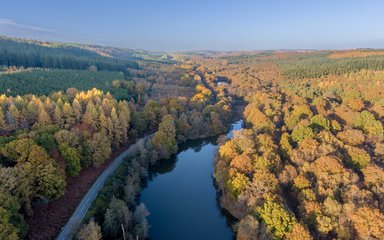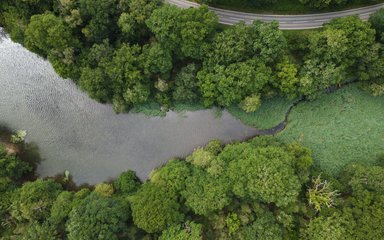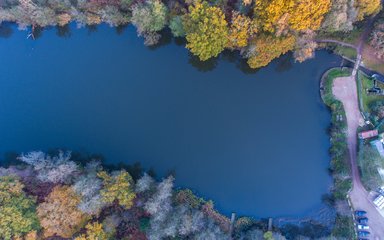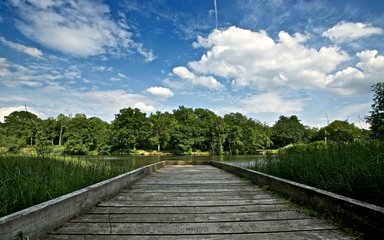
Here is a list of frequently asked questions for the Cannop Ponds project. If you have a question that is not answered here, please email us at cannopponds@forestryengland.uk.
As large bodies of water, held back by earth dams, Cannop Ponds fall under the remit of the Reservoirs Act 1975. We are legally required – for the safety of communities downstream – to address several issues with the ageing reservoir dams and their spillways at Cannop Ponds.
The more we looked at what would be needed to address the issues with the Ponds, the more we could see opportunities to improve the site for the community and wildlife, whilst also protecting those downstream.
Read more about the history of the project here.
Since autumn 2022 we have carried out site investigations and survey work. With our expert partners, engineering consultancy Arup, we produced four potential options that could meet the project objectives and sought the community’s views on those options.
The four options were evaluated against the project objectives. This helped us narrow down the options and make a decision on the best way forward.
Full details of the assessment can be found in the Outline Business Case which was approved by our Executive Board in January 2024.
Lower Cannop will continue to be a large reservoir in the heart of the Forest of Dean. Engineering works will be carried out to build a new larger spillway and make the existing dam watertight, protecting the dam from the risk of failure.
The new spillway will be a sturdy, reinforced concrete structure, that extends further into the reservoir. This design will allow it to handle a greater volume of water, especially during heavy storms, which are becoming more common due to climate change. The exact dimensions will be confirmed during the detailed design stages to follow.
At the same time a cut-off wall will be constructed along the length of the dam, to prevent water continuing to seep through the earth embankment. This will mostly be hidden below ground level and the dam will be re-profiled slightly so that it is not intrusive.
Water levels could potentially be lowered by up to two metres. This will create extra capacity to hold water during periods of heavy rainfall, further improving flood protection for areas downstream.
At Upper Cannop, we're taking a more natural approach to our work. This means less heavy engineering and a greater focus on creating a rich and diverse environment. We will be creating a new mix of habitats, including marshland and reedbeds, while keeping large areas of open water. This will be a haven for a wide variety of wildlife.
By creating shallower edges around the water, we'll encourage the growth of more plants and invertebrates. This provides a perfect feeding ground for an increased number of wintering birds like mallards, gadwalls, and tufted ducks.
The new landscape will offer better feeding opportunities for rare local bat species, including the lesser horseshoe and Natterer's bat.
Otters will continue to find plenty of food, and they may also benefit from a quieter, improved habitat with less disturbance.
The expanded wetland areas will provide more space for amphibians and dragonflies to breed and flourish.
The earth embankment at Upper Cannop is in poor condition and would require very substantial engineering work, and the current spillway is also far too small to meet the standards of the Reservoir Act. Both of these changes would significantly impact the visual appeal of the site.
A more natural approach will see the current embankment retained and the focus will be on improving wetland habitats and creating a haven for wildlife.
Yes, in the long-term Cannop Ponds will continue to be an important place for local people and visitors. We will continue to welcome people of all ages, abilities and backgrounds to enjoy the wellbeing benefits of nature and the outdoors. Accessibility will be improved, to provide a space that everyone can enjoy.
Access will be restricted during construction. The car park at Cannop Ponds will be closed whilst the construction project is underway as it will be used as the main construction depot and site offices. This will avoid areas of woodland needing to be cleared for that purpose. Public rights of way will be diverted to avoid the site.
The car park and picnic areas will be reinstated once construction is completed.
The Colliers Trail (formerly known as the Family Cycle Trail) will be diverted to avoid the construction works and allow the trail to continue being used used throughout the construction phase. This new route will become the new permanent route for the trail, as it will mean cyclists will no longer need to share the driveway with cars. There will still be the option to cycle to and from Cannop Ponds.
We have been working with engineering partners Balfour Beatty and Mott MacDonald to develop the engineering proposals further. These proposals will be shared with the public and we will use your feedback to make further refinements. The final design will then be submitted in a planning application in 2026.
We hope to start a works as soon as the planning application is approved. It will likely take around two years to complete.
The changes we are making at Cannop Ponds will help protect nearby communities from flooding. By increasing the amount of storm water the reservoirs can hold, we can reduce the risk of flooding downstream during heavy rainfall.
Currently, the dams are vulnerable during major storms. Their spillways, which act like overflow drains, are too small to handle the large volumes of water we could see. When a spillway is too small, water can flow over the top of the dam—a situation known as "over-topping." This is a common cause of dam failures worldwide.
With climate change making extreme storms more likely, it is essential to upgrade these structures. The new, larger spillway at Lower Cannop will be able to safely manage a much greater amount of water, protecting the dam for the future. The spillway at Upper Cannop will also be completely replaced, securing it against the risk of failure.
In the long-term, the changes at Upper Cannop will hugely benefit wildlife and complement the retention of the large body of water at Lower Cannop. Our work will safeguard the protected species that currently call the ponds home throughout the entire design and construction process. At Upper Cannop, we will maintain areas of open water for native fish and other aquatic life. In addition, we are creating a more diverse and dynamic landscape with new marshes and reedbeds. These new habitats will provide significant benefits for a wide range of wildlife, including wetland birds, dragonflies, and otters.
This project is dedicated to enhancing the area's value for wildlife and is legally committed to achieving "biodiversity net gain," which means leaving the local environment in a measurably better condition than it was before.
The construction phase will cause some temporary disruption. To ensure the highest level of protection for the area's wildlife during this period, the project will be strictly guided by two important assessments:
- an Environmental Impact Assessment (EIA): this is a comprehensive evaluation of the project's potential environmental effects, ensuring that steps are taken to avoid or minimize them.
- a Habitat Regulations Assessment (HRA): this assessment specifically focuses on ensuring that the project will not negatively impact protected habitats and species.
We are collaborating closely with environmental experts and regulatory agencies to lessen the impact of construction. Our shared goal is to see the new and improved habitats flourish as quickly as possible once the work is complete.
Upper and Lower Cannop Ponds were built around 200 years ago to provide water to Parkend Ironworks.
The dams and spillways have changed over the years, and the heritage value is less about the structures themselves, and more about the landscape heritage of the water bodies in the valley.
Keeping the Lower Cannop dam allows for interpretation of the Bixslade Tramway Crossing, and its historic importance, taking stone from the quarries high up on the valley sides, down to the ‘railway’ in the valley bottom. The current stone works is part of that same landscape heritage and will be largely unaffected by the project.
A lot of the earth embankment at Upper Cannop will be retained, again making that link to the past, however the spillway will be removed, and other alterations will need to be made.
The hydroplant at Lower Cannop will be removed and will not be replaced. The existing hydroplant isn’t very efficient due to the way the reservoirs work. Hydroplants need more reliable conditions with constant high flows – the flows at Lower Cannop are unreliable, and that won’t change as a result of the scheme.
From a historical perspective, getting an adequate and reliable flow of water for the waterwheel at Parkend Ironworks was troublesome from the start, and the hydroplant has suffered from the same issue.
The fishing rights at Cannop Ponds have been let to the Yorkley Angling Club for many decades. This arrangement will continue on Lower Cannop, with new fishing platforms installed by the project, along with improved access paths. Members of Yorkley Angling Club will continue to be able to fish at Lower Cannop when construction work is completed.




